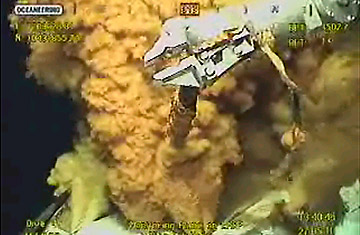
A video grab taken from a BP live video feed shows a robotic arm using a wrench during the top-kill procedure to stop the flow of oil from the Gulf of Mexico spill
If BP is proving itself inexpert at running a drilling platform and managing a spill, it's even worse at managing expectations. As day 39 of the Deepwater Horizon crisis dawned, Americans woke up to the reality that at the very least, there will be a day 40 and a day 41. The top-kill procedure, which began at 2 p.m. on Wednesday, May 26, and was advertised as a 24-hour operation, will now, BP concedes, likely run through the weekend. That news came just a day after the company, which has spent the past month insisting that oil was leaking from the busted well at a rate of 5,000 bbl. a day, had to grapple with new government estimates that put the figure at up to a whopping 25,000.
"This is clearly an environmental catastrophe. There are no two ways about it," Tony Hayward, the CEO of BP, acknowledged on CNN Friday morning, May 28. If that was not news to the residents of the Gulf, it seemed to be to BP, which had spent weeks arguing that the damage could be controlled and contained.
BP's relationship with candor has been complicated, and nothing has illustrated that like the top kill, in which a 30,000-horsepower engine has been used to force 50,000 bbl. of drilling mud into the broken riser pipe to choke off the flow of oil. For the better part of 10 days, company spokespeople promised that the operation was just a day or two away. When it finally began, they predicted that its effectiveness would be clear within a day. From Wednesday afternoon to Thursday afternoon, the networks broadcast saturation coverage of the unfolding operation and BP reps issued encouraging reports that things were proceeding as hoped. But late Thursday, BP chief operating officer Rick Suttles held a press conference at which he admitted that not only had the leak not been closed, but also the pumping had stopped entirely, just 10 hours after it began, as the company reassessed its methods and adjusted the density and pressure of the mud it was using.
"I probably should apologize to folks that we haven't been giving more data on that," Suttles said. "It was nothing more than [that] we are so focused on the operation itself." Maybe. But for 18 hours, the networks had unknowingly been serving up the misinformation that the pumping was going on nonstop, and no one from BP had stepped forward to offer a correction.
The pumping resumed Thursday night, accompanied by a so-called junk shot, in which shredded tires and other debris were added to the incoming mud. The next morning, BP CEO Hayward made a weary round of the morning news shows with a much less optimistic prognosis than the one the company had been peddling.
"We don't know whether we will be able to overcome the well," he said on NBC's Today show. The pumping will continue for at least 48 hours, with a probability of success that BP still puts at 60% to 70%. Admiral Thad Allen, the Coast Guard commander of spill operations, believes it might not take a full two days before there is clarity; success or failure could be known by late on May 28 or early on May 29, he said.
In the event the news isn't good, BP is preparing its Plan B — actually Plan C or D by now — the much discussed top hat, or what the company prefers to call the lower marine riser package (LMRP). A 12-ft. containment dome, the LMRP is already on the ocean floor, adjacent to the spill site. If using it becomes necessary, robot submersibles will first saw off much of the broken riser pipe, leaving a short stump with a clean cut at the top. Hoists will then lift the LMRP and settle it into position so it covers the gushing oil. The top of the pipe should fit into an opening at the top of the dome, and a mile-long tube would then carry the oil to tankers on the surface. BP claims that the setup work, once begun, will take three or four days — which may or may not actually mean three or four days, given the company's history.
All of this is occurring on a day when a damning report from the Occupational Safety and Health Administration is making the rounds, documenting BP's woeful safety record since 2007. According to the report, the company received 862 safety citations from June 2007 to February 2010, 760 of which were labeled "egregious and willful." How many such black marks did competitors Sunoco, Conoco-Phillips, Citgo and Exxon have in the same period? Eight, eight, two and one, respectively. It will surely take years to clean up the muck BP has spilled in the Gulf, but that may be nothing compared to the time it will take to clean the company's soiled name.
